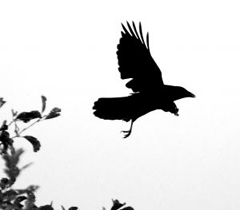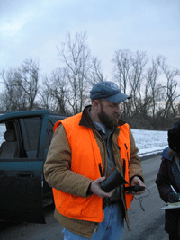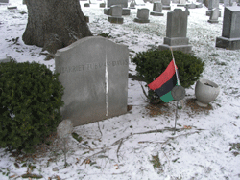Kicking out the Crows
Air Date: Week of April 17, 2009

In celebration of Earth Month, Living on Earth is revisiting some of our favorite stories. This week we go back to 2006 in Auburn, New York. Producer Sy Montgomery visited the town which each winter was invaded by hundreds of thousands of crows. No one knew exactly why the birds came but the scene they created – and the mess – had residents divided over whether to embrace the crows or drive them out. We’ll hear an excerpt from Sy’s piece and then host Jeff Young talks with Auburn Superintendent of Public Works, Jerry Delfavero, to find out whether the crows are still a problem.
Transcript
YOUNG: In honor of Earth Day, we’ve been digging into the Living on Earth archives for some favorite stories and catching up on new developments.
[SOUND OF CROWS]
YOUNG: Today we revisit a rather ominous report from 2006, one that could have come from a Hitchcock classic.
LATTIMORE: They're so thick; it's almost like out of the movie "The Birds."
YOUNG: For citizens of Auburn, New York, the invasion of crows is not Hollywood fiction – each winter it's been daily reality.
LATTIMORE: It's a gigantic black explosion – the noise, the beauty of the whole thing, it was beautiful. If that was on television I'd watch it. I'd love that.
YOUNG: When producer Sy Montgomery visited Auburn to report on a city inundated with crows, she found residents divided over whether the birds were a blessing or a curse.
MONTGOMERY: Auburn is a small city. A city of fine old churches and pretty little parks located about 25 miles southwest of Syracuse, as the crow flies. And each winter, a lot of crows do fly to this community of 28,000 people. Tens of thousands of them.
[CROW SOUNDS]
MONTGOMERY: The spectacle begins around dusk: a river of black wings, the air alive with noisy, hurrying birds flowing down from the sky. No one knows exactly why crows mass in the winter. Ornithologists think they do it to share information, or ward off predators with sheer numbers. Whatever the reason, crows have been roosting in Auburn for at least 100 years. They used to keep to the outskirts, but lately they've been coming downtown. Maybe it's the fine dining.
LATTIMORE: They know our trash routes better than our sanitation department!
MONTGOMERY: That's Auburn's Mayor, Tim Lattimore. When he took office, downtown Auburn's crow roost was the biggest in the state. Last winter, biologists counted 63,000 of them. In Auburn, in winter, crows are the talk of the town. Some folks welcome them; others are intimidated by so many black birds. But on one point, most agree: tens of thousands of crows can leave your city in, well, deep doo-doo.
LATTIMORE: I mean there are some businesses that we have here in town, such as the bank, the girls would have to leave and wear their umbrellas. Our local YMCA, when the people came out at night, they would normally get hit two or three times.
MONTGOMERY: Though experts assure the birds pose no threat of transmitting, say, bird flu, the crows do present the mayor with a big public relations problem.
LATTIMORE: I'm trying to attract Fortune 500 companies, and with the droppings that the birds were giving, I mean people would walk in City Hall with fecal matter on their feet. It's just not cleanly. It just doesn't give the right presentation that we want to give off here in the city of Auburn.
MONTGOMERY: So he called in the U.S. Department of Agriculture's Wildlife Services Program. Biologist Rich Chipman is the New York state director.

USDA biologist Rich Chipman prepares to go out with teams for crow harassment.(Photo: Rachel Gotbaum)
MONTGOMERY: For a week, Chipman and eight federal scientists team up with eight city employees, including Dave "Spider" Ganey, who's been working Auburn's streets for 35 years.
CHAPMAN: [ON CELL PHONE] Here, let me give you to Spider.
GANEY: VanAnden Street? Give us about two minutes. We're about two minutes away from there.
MONTGOMERY: Wearing blaze orange vests and driving trucks boldly labeled USDA Wildlife Services, these men are on a mission: to drive as many crows out of town as they can.
[TRAVEL SOUNDS]
MONTGOMERY: Tonight, we head for one of the birds' favorite spots, a neighborhood of tall pines and oaks, not far from a ball field.
CHIPMAN: This is prime time, about 6 o’clock, when we would certainly expect to see crows trying to roost here for the night.
MONTGOMERY: The team's arsenal is completely non-lethal, but effective:
[CROW DISTRESS CALL]
MONTGOMERY: A tape recording of a crow distress call broadcasts the news that this is no place to spend the night. Shining a bright red laser into the trees makes the crows nervous. Pretty soon, the flock gets the message:
[SOUNDS OF FLYING AND WINGS WITH RECORDED DISTRESS CALL IN BACKGROUND]
MONTGOMERY: As thousands of crows flee the trees, their wing beats sound like a rainstorm, and their deep black forms against the gray sky look like night itself taking flight.
[SOUNDS OF FLYING AND WINGS WITH RECORDED DISTRESS CALL IN BACKGROUND]
[SOUND OF DOG BARKING]
MONTGOMERY: Each night, teams try to hit all the crow hotspots, like a little park on the west side of town.
CHIPMAN: Here, along the back of the bench, you can see whitewash. This is all crow dropping in here, it's really impacted people's ability to enjoy the area.
GANEY: I work for the city, so I see it all the time. The parking meters were so bad you couldn't even put money in them, they'd be dripping with this.
MONTGOMERY: But in the grove of trees where the birds typically roost, we find none tonight. This is the fifth night of the program, and these extremely intelligent birds are learning fast. If they don't leave things will only get worse.
GANEY: Do you have your artillery rounds, Rich? I've got some caps left.
[SOUND OF CAPS AND GETTING OUT CAR.]
[SOUNDS OF GETTING PYRO READY FOR A FEW SECONDS IN TRUCK]
MONTGOMERY: For stubborn crows, Chipman and Spider break out the heavy stuff.
[PYRO SHOOTS OFF]
MONTGOMERY: Screaming rockets shot off from a cap gun zigzag into the night air.

Crow droppings mar the gravestone of Underground Railroad heroine Harriet Tubman. (Photo: Sy Montgomery)
[MORE PYRO SOUNDS]
MONTGOMERY: Near the maximum-security prison, usually a favored spot, one lone crow eyes the USDA truck suspiciously from the top of a tall tree.
CHIPMAN: Quite often before they roost they'll send in a sentinel or a scout to make sure things are OK, and you can see this guy that just came in here, and he’s looking around, and he's obviously a little nervous. See how he's sort of bobbing back and forth? He may go back and send a message that this isn't the place to go for tonight. They actually communicate back and forth quite a bit.
MONTGOMERY: Word's apparently spreading in Crowdom. So far, 90 percent of the 36,000 crows that showed up this year are gone. After seven days and 14,000 city dollars, downtown Auburn is no longer crow city.
YOUNG: Reporter Sy Montgomery telling us about the crows of New York in that story in 2006. And with us on the phone now to give us the update is the city of Auburn’s superintendent of public works, Jerry DelFavero. Hi Mr. DelFavero?
DELFAVERO: Hi, how are you?
YOUNG: I’m doing well. Thanks for joining us. When Sy Montgomery told us about this just three years ago you had more than 30,000 crows. How many this year?
DELFAVERO: We’re down to thousands. I mean it’s a manageable flock. I mean, you wouldn’t even know it’s a problem in Auburn anymore.
YOUNG: And remind us you’re doing what – this scare crows and tying a pie tin on the top of a tree – it’s a little more sophisticated than that.

Mayor Tim Lattimore has paid the USDA to scare crows from the city. (Photo: Rachel Gotbaum)
YOUNG: It sounds like this costs a lot of money though.
DELFAVERO: Actually, when we were going to contract with the USDA it was a pretty big amount but it was worth it even at that. But now with us doing it, we purchase our own equipment, we probably got around $2500 worth of equipment purchased. And with our labor, it’s – the guys have gotta be here anyways – we’re using them for an eight hour day, and six to eight guys out of seventy employees that we have at the public works. So it really isn’t that costly for us at this time, you know, with us doing it ourselves. It’s working very well.
YOUNG: And I guess you’ve got to be saving some money in terms of the – you don’t have as much crow excrement to deal with.
DELFAVERO: Well, I can tell you right now that in the last few years we’ve had a handful of crow complaints. I mean, ten, twelve years ago, eight years ago, seven years ago – I mean it was constant daily. It was – I mean, we were getting calls all the time. “What are we going to do about this?” “I can’t get down my sidewalk.” “My car’s covered with it. You gonna pay for washing it?” It was like a constant barrage of calls. Now that’s a handful of year. And that’s because you might have a 100 crows in one tree near a residential area or whatever.

DELFAVERO: Well, you know what, we still got salt and snow and dirt
[LAUGHING]
DELFAVERO: So, you know, I mean, you still gotta wash your car – you know, fortunately or unfortunately however you wanna look at it. You don’t have those big white globs all over everything. So I’m glad it’s happening and no crows are being hurt. Unfortunately, I get calls from other surrounding towns and cities wantin’ to know why I sent the birds over to them or whatever.
YOUNG: And where do they go?
DELFAVERO: You know on the outskirts. There’s a lot of rural areas outside of Auburn and hopefully that’s where they’re going. I really can’t pin point, you know. We don’t take the birds or whatever. But you know, it is working and if they’re going back out to the country and into the cornfields, that’s great.
YOUNG: You know this might seem like a strange question for someone who’s devoted so much time to chasing these birds away, but I’m wondering – do you miss them a little bit because …
DELFAVERO: Oh sure, sure.
YOUNG: … it was kind of a phenomenon.
DELFAVERO: Well, let me tell you – and, you know, I’ve been with the city for over thirty years. I mean, just going down, we have an arterial that goes through the town, just going down, if we were down visiting the mall with my family or whatever, the first thing you would do at six o’clock during the winter months is look up to the sky and be amazed at how many crows were there. It was quite a sight to see – I mean, if you’ve never seen if, you would be shocked. If you were driving through town, you’d probably pull over just to watch that event. It was quite an amazing, amazing sight to see such a flock coming in and going out of Auburn.
YOUNG: Jerry DelFavero is superintendent of the public works department for the city of Auburn in New York talking to us about dealing with far too many crows. Thanks very much for your time. I appreciate it.
DELFAVERO: Okay, thank you. Yup. Bye.
[MUSIC: Joni Mitchell “Black Crow” from Hejira (Asylum Records 1976)]
YOUNG: Just ahead – notes to celebrate Earth Day – and its 39h birthday. Stay with us - on Living on Earth.
ANNOUNCER: Support for the Environmental Health Desk at Living on Earth comes from the Cedar Tree Foundation. Support also comes from the Richard and Rhoda Goldman fund for coverage of population and the environment. And from Gilman Ordway for coverage of conservation and environmental change. This is Living on Earth on PRI, Public Radio International.
[CUTAWAY MUSIC: Chico Hamilton “Nonchalant” from Twelve Tones Of Love (Joyous Shout 2009)]
Living on Earth wants to hear from you!
Living on Earth
62 Calef Highway, Suite 212
Lee, NH 03861
Telephone: 617-287-4121
E-mail: comments@loe.org
Newsletter [Click here]
Donate to Living on Earth!
Living on Earth is an independent media program and relies entirely on contributions from listeners and institutions supporting public service. Please donate now to preserve an independent environmental voice.
NewsletterLiving on Earth offers a weekly delivery of the show's rundown to your mailbox. Sign up for our newsletter today!
 Sailors For The Sea: Be the change you want to sea.
Sailors For The Sea: Be the change you want to sea.
 The Grantham Foundation for the Protection of the Environment: Committed to protecting and improving the health of the global environment.
The Grantham Foundation for the Protection of the Environment: Committed to protecting and improving the health of the global environment.
 Contribute to Living on Earth and receive, as our gift to you, an archival print of one of Mark Seth Lender's extraordinary wildlife photographs. Follow the link to see Mark's current collection of photographs.
Contribute to Living on Earth and receive, as our gift to you, an archival print of one of Mark Seth Lender's extraordinary wildlife photographs. Follow the link to see Mark's current collection of photographs.
 Buy a signed copy of Mark Seth Lender's book Smeagull the Seagull & support Living on Earth
Buy a signed copy of Mark Seth Lender's book Smeagull the Seagull & support Living on Earth

